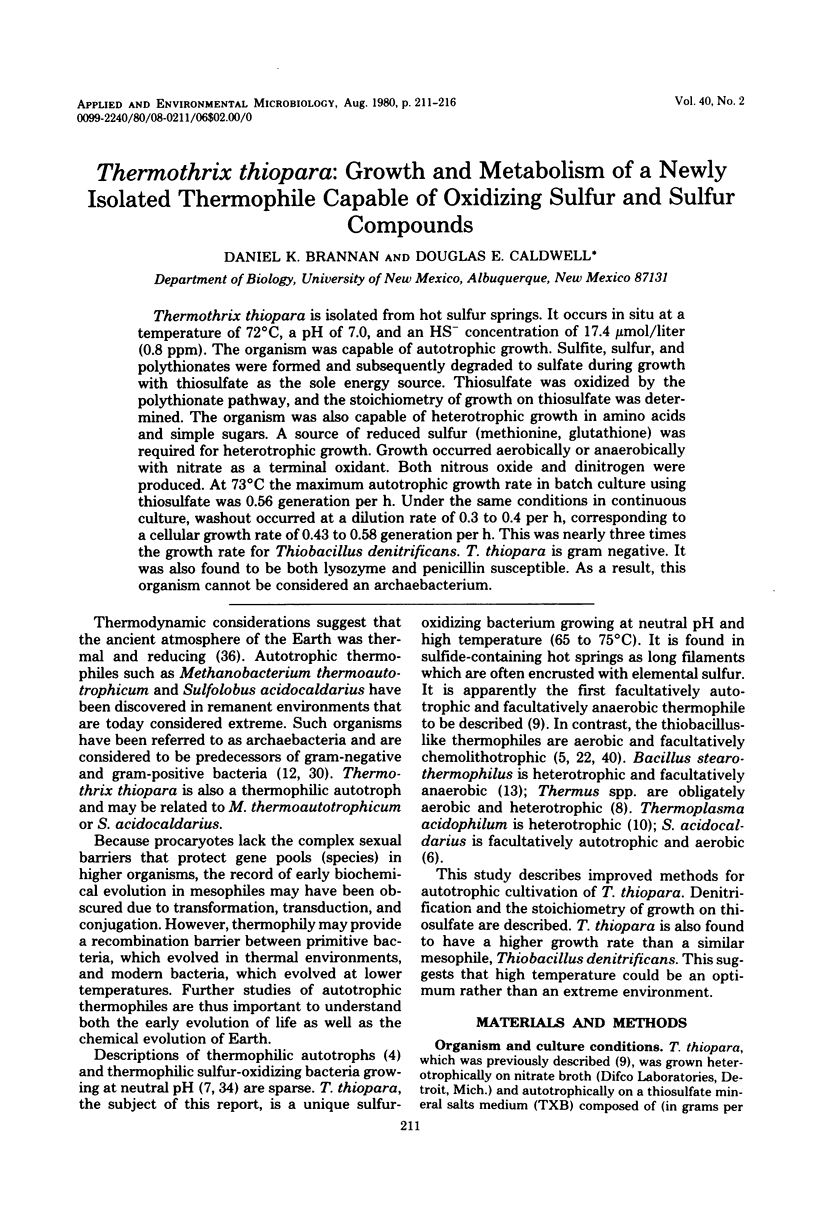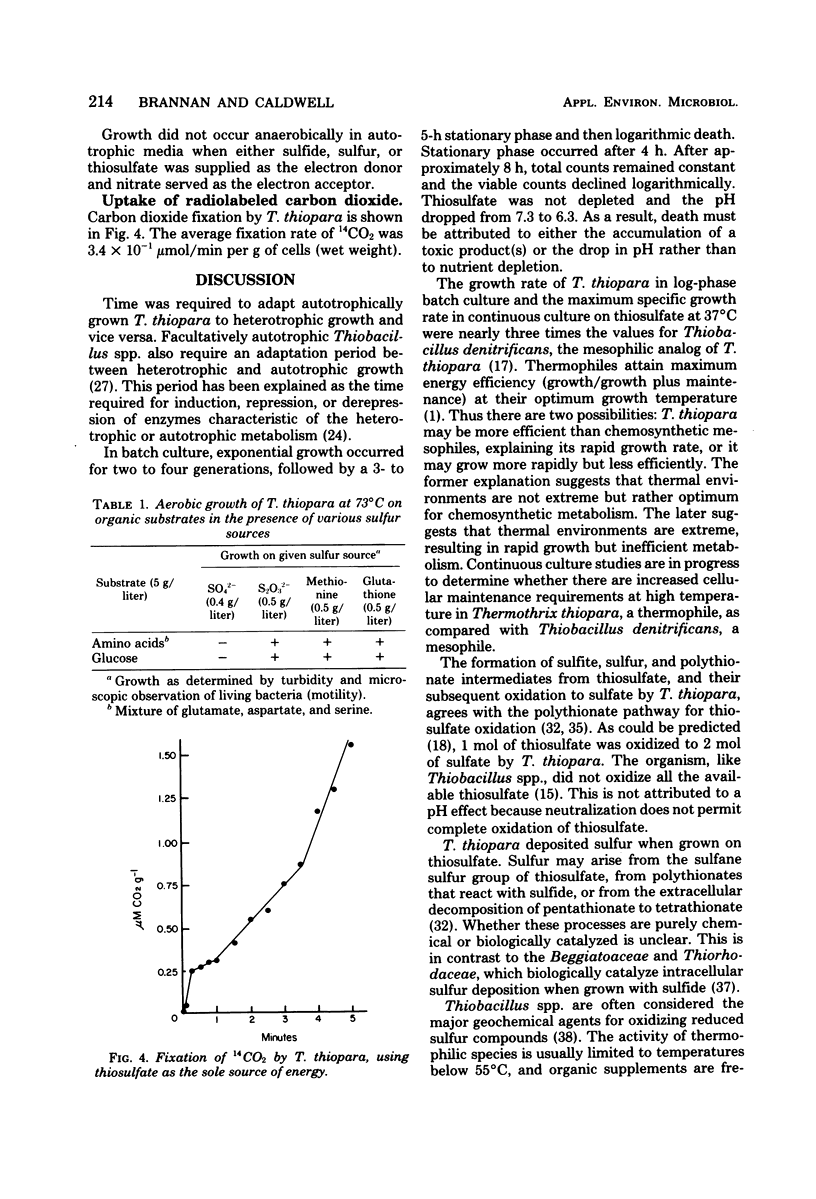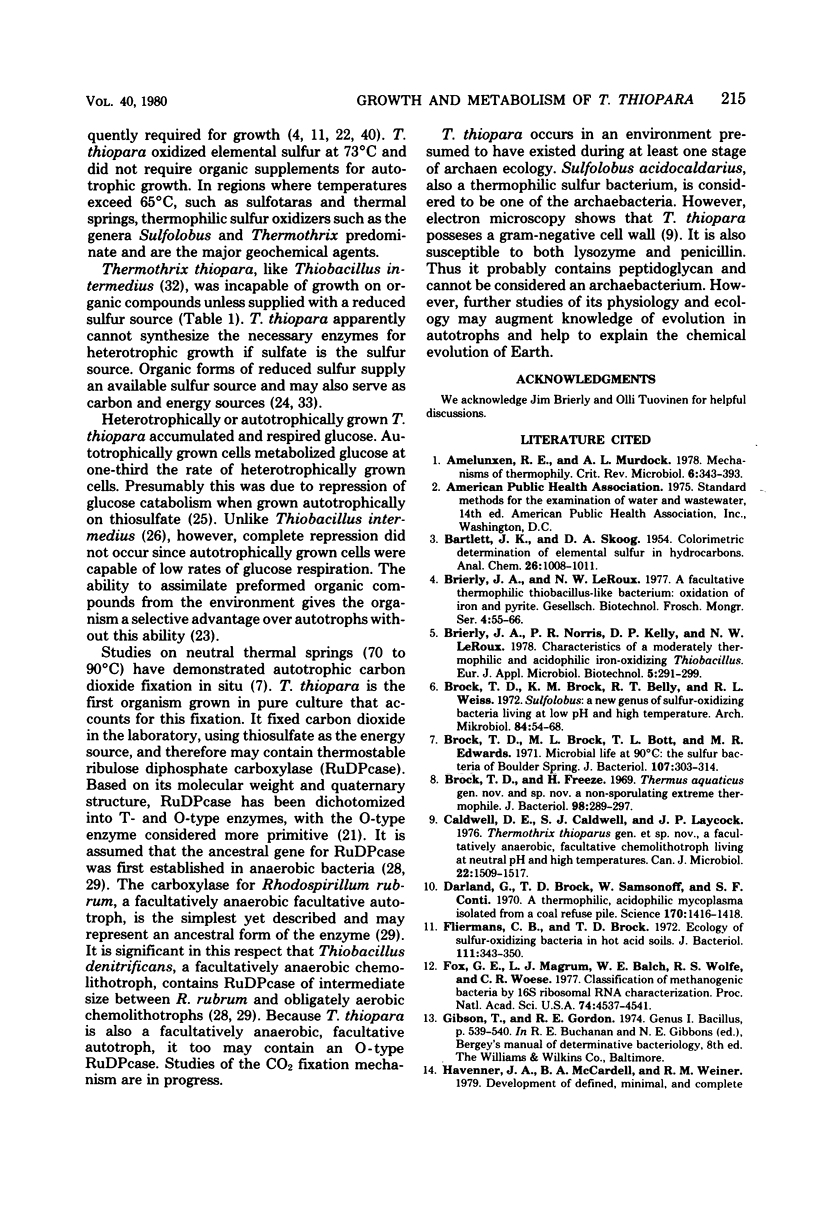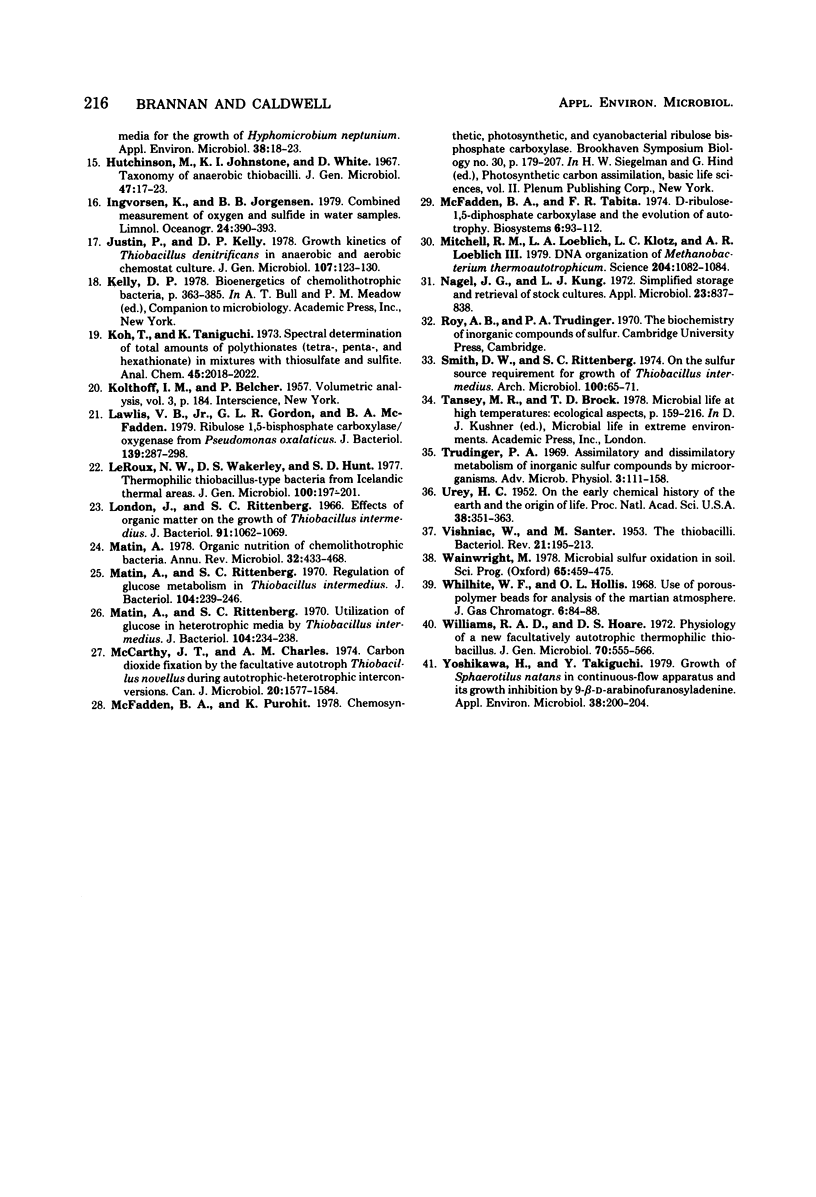Abstract
Thermothrix thiopara is isolated from hot sulfur springs. It occurs in situ at a temperature of 72°C, a pH of 7.0, and an HS- concentration of 17.4 μmol/liter (0.8 ppm). The organism was capable of autotrophic growth. Sulfite, sulfur, and polythionates were formed and subsequently degraded to sulfate during growth with thiosulfate as the sole energy source. Thiosulfate was oxidized by the polythionate pathway, and the stoichiometry of growth on thiosulfate was determined. The organism was also capable of heterotrophic growth in amino acids and simple sugars. A source of reduced sulfur (methionine, glutathione) was required for heterotrophic growth. Growth occurred aerobically or anaerobically with nitrate as a terminal oxidant. Both nitrous oxide and dinitrogen were produced. At 73°C the maximum autotrophic growth rate in batch culture using thiosulfate was 0.56 generation per h. Under the same conditions in continuous culture, washout occurred at a dilution rate of 0.3 to 0.4 per h, corresponding to a cellular growth rate of 0.43 to 0.58 generation per h. This was nearly three times the growth rate for Thiobacillus denitrificans. T. thiopara is gram negative. It was also found to be both lysozyme and penicillin susceptible. As a result, this organism cannot be considered an archaebacterium.
Full text
PDF





Selected References
These references are in PubMed. This may not be the complete list of references from this article.
- Amelunxen R. E., Murdock A. L. Mechanisms of thermophily. CRC Crit Rev Microbiol. 1978;6(4):343–393. doi: 10.3109/10408417809090626. [DOI] [PubMed] [Google Scholar]
- Brock T. D., Brock K. M., Belly R. T., Weiss R. L. Sulfolobus: a new genus of sulfur-oxidizing bacteria living at low pH and high temperature. Arch Mikrobiol. 1972;84(1):54–68. doi: 10.1007/BF00408082. [DOI] [PubMed] [Google Scholar]
- Brock T. D., Brock M. L., Bott T. L., Edwards M. R. Microbial life at 90 C: the sulfur bacteria of Boulder Spring. J Bacteriol. 1971 Jul;107(1):303–314. doi: 10.1128/jb.107.1.303-314.1971. [DOI] [PMC free article] [PubMed] [Google Scholar]
- Brock T. D., Freeze H. Thermus aquaticus gen. n. and sp. n., a nonsporulating extreme thermophile. J Bacteriol. 1969 Apr;98(1):289–297. doi: 10.1128/jb.98.1.289-297.1969. [DOI] [PMC free article] [PubMed] [Google Scholar]
- Caldwell D. E., Caldwell S. J., Laycock J. P. Thermothrix thioparus gen. et sp. nov. a facultatively anaerobic facultative chemolithotroph living at neutral pH and high temperature. Can J Microbiol. 1976 Oct;22(10):1509–1517. doi: 10.1139/m76-223. [DOI] [PubMed] [Google Scholar]
- Darland G., Brock T. D., Samsonoff W., Conti S. F. A thermophilic, acidophilic mycoplasma isolated from a coal refuse pile. Science. 1970 Dec 25;170(3965):1416–1418. doi: 10.1126/science.170.3965.1416. [DOI] [PubMed] [Google Scholar]
- Fliermans C. B., Brock T. D. Ecology of sulfur-oxidizing bacteria in hot acid soils. J Bacteriol. 1972 Aug;111(2):343–350. doi: 10.1128/jb.111.2.343-350.1972. [DOI] [PMC free article] [PubMed] [Google Scholar]
- Fox G. E., Magrum L. J., Balch W. E., Wolfe R. S., Woese C. R. Classification of methanogenic bacteria by 16S ribosomal RNA characterization. Proc Natl Acad Sci U S A. 1977 Oct;74(10):4537–4541. doi: 10.1073/pnas.74.10.4537. [DOI] [PMC free article] [PubMed] [Google Scholar]
- Hutchinson M., Johnstone K. I., White D. Taxonomy of anaerobic thiobacilli. J Gen Microbiol. 1967 Apr;47(1):17–23. doi: 10.1099/00221287-47-1-17. [DOI] [PubMed] [Google Scholar]
- Lawlis V. B., Jr, Gordon G. L., McFadden B. A. Ribulose 1,5-bisphosphate carboxylase/oxygenase from Pseudomonas oxalacticus. J Bacteriol. 1979 Jul;139(1):287–298. doi: 10.1128/jb.139.1.287-298.1979. [DOI] [PMC free article] [PubMed] [Google Scholar]
- London J., Rittenberg S. C. Effects of organic matter on the growth of Thiobacillus intermedius. J Bacteriol. 1966 Mar;91(3):1062–1069. doi: 10.1128/jb.91.3.1062-1069.1966. [DOI] [PMC free article] [PubMed] [Google Scholar]
- Matin A. Organic nutrition of chemolithotrophic bacteria. Annu Rev Microbiol. 1978;32:433–468. doi: 10.1146/annurev.mi.32.100178.002245. [DOI] [PubMed] [Google Scholar]
- Matin A., Rittenberg S. C. Regulation of glucose metabolism in Thiobacillus intermedius. J Bacteriol. 1970 Oct;104(1):239–246. doi: 10.1128/jb.104.1.239-246.1970. [DOI] [PMC free article] [PubMed] [Google Scholar]
- Matin A., Rittenberg S. C. Utilization of glucose in heterotrophic media by Thiobacillus intermedius. J Bacteriol. 1970 Oct;104(1):234–238. doi: 10.1128/jb.104.1.234-238.1970. [DOI] [PMC free article] [PubMed] [Google Scholar]
- McCarthy J. T., Charles A. M. CO2 fixation by the facultative autotroph Thiobacillus novellus during autotrophy-heterotrophy interconversions. Can J Microbiol. 1974 Nov;20(11):1577–1584. doi: 10.1139/m74-244. [DOI] [PubMed] [Google Scholar]
- McFadden B. A., Purohit K. Chemosynthetic, photosynthetic, and cyanobacterial ribulose bisphosphate carboxylase. Basic Life Sci. 1978;11:179–207. doi: 10.1007/978-1-4684-8106-8_13. [DOI] [PubMed] [Google Scholar]
- McFadden B. A., Tabita F. R. D-ribulose-1, 5-diphosphate carboxylase and the evolution of autotrophy. Biosystems. 1974 Oct;6(2):93–112. doi: 10.1016/0303-2647(74)90002-1. [DOI] [PubMed] [Google Scholar]
- Mitchell R. M., Loeblich L. A., Klotz L. C., Loeblich A. R., 3rd DNA organization of Methanobacterium thermoautotrophicum. Science. 1979 Jun 8;204(4397):1082–1084. doi: 10.1126/science.377486. [DOI] [PubMed] [Google Scholar]
- Ngel J. G., Kunz L. J. Simplified storage and retrieval of stock cultures. Appl Microbiol. 1972 Apr;23(4):837–838. doi: 10.1128/am.23.4.837-838.1972. [DOI] [PMC free article] [PubMed] [Google Scholar]
- Smith D. W., Rittenberg S. C. On the sulfur-source requirement for growth of Thiobacillus intermedius. Arch Microbiol. 1974;100(1):65–71. doi: 10.1007/BF00446307. [DOI] [PubMed] [Google Scholar]
- Urey H. C. On the Early Chemical History of the Earth and the Origin of Life. Proc Natl Acad Sci U S A. 1952 Apr;38(4):351–363. doi: 10.1073/pnas.38.4.351. [DOI] [PMC free article] [PubMed] [Google Scholar]
- VISHNIAC W., SANTER M. The thiobacilli. Bacteriol Rev. 1957 Sep;21(3):195–213. doi: 10.1128/br.21.3.195-213.1957. [DOI] [PMC free article] [PubMed] [Google Scholar]
- Williams R. A., Hoare D. S. Physiology of a new facultatively autotrophic thermophilic thiobacillus. J Gen Microbiol. 1972 May;70(3):555–566. doi: 10.1099/00221287-70-3-555. [DOI] [PubMed] [Google Scholar]
- Yoshikawa H., Takiguchi Y. Attached Growth of Sphaerotilus natans in Continuous-Flow Apparatus and Its Growth Inhibition by 9-beta-d-Arabinofuranosyladenine. Appl Environ Microbiol. 1979 Aug;38(2):200–204. doi: 10.1128/aem.38.2.200-204.1979. [DOI] [PMC free article] [PubMed] [Google Scholar]


